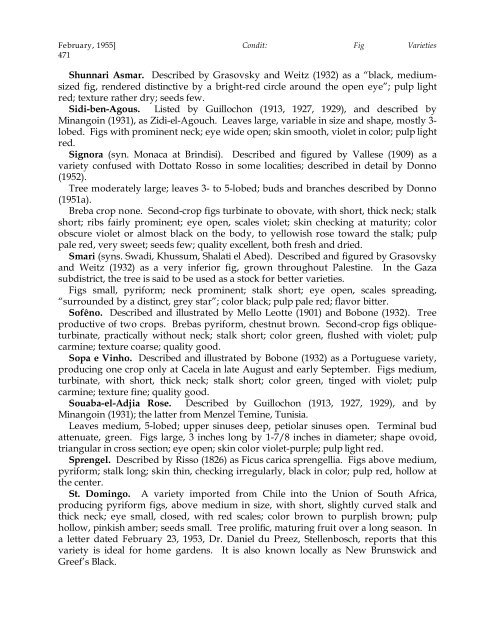Fig Varieties: A Monograph - uri=ucce.ucdavis
Fig Varieties: A Monograph - uri=ucce.ucdavis
Fig Varieties: A Monograph - uri=ucce.ucdavis
Create successful ePaper yourself
Turn your PDF publications into a flip-book with our unique Google optimized e-Paper software.
February, 1955] Condit: <strong>Fig</strong> <strong>Varieties</strong><br />
471<br />
Shunnari Asmar. Described by Grasovsky and Weitz (1932) as a “black, mediumsized<br />
fig, rendered distinctive by a bright-red circle around the open eye”; pulp light<br />
red; texture rather dry; seeds few.<br />
Sidi-ben-Agous. Listed by Guillochon (1913, 1927, 1929), and described by<br />
Minangoin (1931), as Zidi-el-Agouch. Leaves large, variable in size and shape, mostly 3-<br />
lobed. <strong>Fig</strong>s with prominent neck; eye wide open; skin smooth, violet in color; pulp light<br />
red.<br />
Signora (syn. Monaca at Brindisi). Described and figured by Vallese (1909) as a<br />
variety confused with Dottato Rosso in some localities; described in detail by Donno<br />
(1952).<br />
Tree moderately large; leaves 3- to 5-lobed; buds and branches described by Donno<br />
(1951a).<br />
Breba crop none. Second-crop figs turbinate to obovate, with short, thick neck; stalk<br />
short; ribs fairly prominent; eye open, scales violet; skin checking at maturity; color<br />
obscure violet or almost black on the body, to yellowish rose toward the stalk; pulp<br />
pale red, very sweet; seeds few; quality excellent, both fresh and dried.<br />
Smari (syns. Swadi, Khussum, Shalati el Abed). Described and figured by Grasovsky<br />
and Weitz (1932) as a very inferior fig, grown throughout Palestine. In the Gaza<br />
subdistrict, the tree is said to be used as a stock for better varieties.<br />
<strong>Fig</strong>s small, pyriform; neck prominent; stalk short; eye open, scales spreading,<br />
“surrounded by a distinct, grey star”; color black; pulp pale red; flavor bitter.<br />
Sofêno. Described and illustrated by Mello Leotte (1901) and Bobone (1932). Tree<br />
productive of two crops. Brebas pyriform, chestnut brown. Second-crop figs obliqueturbinate,<br />
practically without neck; stalk short; color green, flushed with violet; pulp<br />
carmine; texture coarse; quality good.<br />
Sopa e Vinho. Described and illustrated by Bobone (1932) as a Portuguese variety,<br />
producing one crop only at Cacela in late August and early September. <strong>Fig</strong>s medium,<br />
turbinate, with short, thick neck; stalk short; color green, tinged with violet; pulp<br />
carmine; texture fine; quality good.<br />
Souaba-el-Adjia Rose. Described by Guillochon (1913, 1927, 1929), and by<br />
Minangoin (1931); the latter from Menzel Temine, Tunisia.<br />
Leaves medium, 5-lobed; upper sinuses deep, petiolar sinuses open. Terminal bud<br />
attenuate, green. <strong>Fig</strong>s large, 3 inches long by 1-7/8 inches in diameter; shape ovoid,<br />
triangular in cross section; eye open; skin color violet-purple; pulp light red.<br />
Sprengel. Described by Risso (1826) as Ficus carica sprengellia. <strong>Fig</strong>s above medium,<br />
pyriform; stalk long; skin thin, checking irregularly, black in color; pulp red, hollow at<br />
the center.<br />
St. Domingo. A variety imported from Chile into the Union of South Africa,<br />
producing pyriform figs, above medium in size, with short, slightly curved stalk and<br />
thick neck; eye small, closed, with red scales; color brown to purplish brown; pulp<br />
hollow, pinkish amber; seeds small. Tree prolific, maturing fruit over a long season. In<br />
a letter dated February 23, 1953, Dr. Daniel du Preez, Stellenbosch, reports that this<br />
variety is ideal for home gardens. It is also known locally as New Brunswick and<br />
Greef’s Black.
















![Fig Trees in North Carolina [Archive] - IDigMyGarden ... - Figs 4 Fun](https://img.yumpu.com/26905320/1/190x245/fig-trees-in-north-carolina-archive-idigmygarden-figs-4-fun.jpg?quality=85)